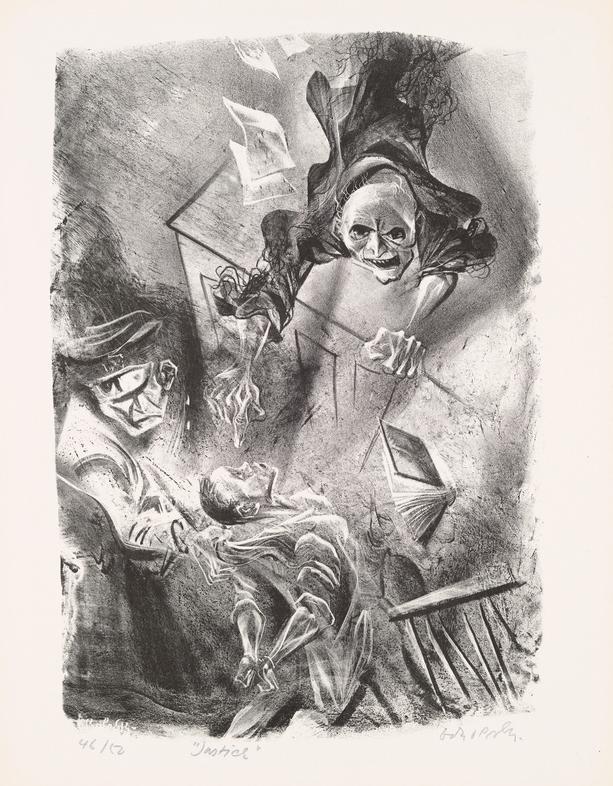The Phillips Collection Presents William Gropper: Artist of the People

The first exhibition in Washington, DC, dedicated to the leading American social realist artist
WASHINGTON, DC—The Phillips Collection presents William Gropper: Artist of the People, the first exhibition in Washington, DC, dedicated to political cartoonist, painter, and printmaker William Gropper (b. 1897, New York, NY; d. 1977, Manhasset, NY). Featuring more than 40 paintings, cartoons, and caricatures this focused exhibition reveals Gropper's biting commentary on human rights, class, labor, freedom, democracy, and the hypocrisy of the American dream. The exhibition spans the artist's most prolific years and reconstructs his political critiques and commitment to social justice for a contemporary audience. The exhibition is on view from October 17, 2024, through January 5, 2025. Press are invited to see the exhibition with the curator, Elsa Smithgall, by appointment on October 17, from 10 am–5 pm. RSVP to lcantrell@phillipscollection.org.
The son of impoverished immigrants from Romania and Ukraine, Gropper grew up poor on the Lower East Side. Witnessing the daily injustices face by the working class during his formative years instilled in him a sympathy for marginalized communities, which greatly influenced his direction as an artist. Gropper contributed thousands of incisive illustrations to Vanity Fair and the New York Tribune, as well as more radical papers like the New Masses, Rebel Worker, and Morning Freiheit. Hailed as the Honoré Daumier of his time due to his sharp criticism of politicians and the government, Gropper developed a powerful artistic language to catalyze social change.
"Gropper was an artist of, by, and for the people, who fervently believed in the power of art to bring people together and effect change," says Vradenburg Director & CEO Jonathan P. Binstock. "Over half a century since their creation, Gropper's work exposes universal human concerns, including the fragility of our democracy, which continue to persist. As an artist who has long been overlooked in the history of 20th-century American art, we are excited to share his work with our guests and spark conversations about its relevance to our contemporary world."
This presentation of Gropper's satires and commentary featured examples produced during a fertile period in the artist's career, between the 1930s and 1950s. During the Great Depression, Gropper, like many of his fellow social realist artists and mentors like Robert Henri and George Bellows, celebrated the importance and inherent dignity of the worker in his art. As a labor activist, Gropper championed unions and defended government programs like the Works Progress Administration (WPA), which provided government jobs for millions of the unemployed and commissioned public artworks by artists who have come to define the American modernist canon including Stuart Davis, Dorothea Lange, Jacob Lawrence, and Jackson Pollock.
"Gropper was a fierce, lifelong social justice advocate who used art to advocate for a better world. He believed strongly that artists be given a 'free hand' to reveal hard truths," says Phillips Chief Curator and exhibition curator Elsa Smithgall. "In addition to his scathing social and political commentary, Gropper also turned to folk heroes and popular imagery from American contemporary discourse to portray optimistic scenes of his vision for an egalitarian society."
Gropper's socially conscious work went beyond support for the worker to the condemnation of racism, fascism, antisemitism, and governmental corruption. In 1936, while on assignment for Vanity Fair, Gropper wielded his brush to document proceedings of the US Senate, where he observed firsthand the shortcomings of democracy as a political system. During World War II, Gropper supported the war effort, creating war bond posters and cartoons condemning domestic and foreign fascists. He produced thousands of cartoons and received numerous commissions for murals throughout the country, including Construction of a Dam in the Department of the Interior building in DC.
In the 1950s, Gropper found himself in the crosshairs of Senator Joseph McCarthy's "Red Scare," becoming the first of only two artists to be blacklisted, with his works banned from State Department traveling shows and many museums and galleries. The results were immediate and devastating, yet this did not diminish his belief in democracy and freedom of expression, nor his critical eye and artistic vigor. Following these dramatic events, Gropper produced his famed 50-print set titled The Capriccios after Spanish artist Francisco de Goya's series of the same name, drawing a provocative parallel between the Spanish Inquisition and McCarthyism. He channeled this dark chapter of paranoia and political scapegoating into his art and regained popular reception in the final decades of his life. He continued to produce works that speak to themes of war, prejudice, greed, and exploitation into his late seventies. By the year of his death, he had shown at most major museums across the country.
William Gropper: Artist of the People is the first exhibition presented by The Phillips Collection dedicated to the artist. In addition to works on loan, the exhibition features a selection of Gropper's paintings, prints, and drawings from the collection of Harvey and Harvey-Ann Ross, many of which recently entered the museum's permanent collection and will be exhibited for the first time.
EXHIBITION SUPPORT
The exhibition is organized by The Phillips Collection and is made possible in part by the generous support of Phillips Trustee Emeritus Harvey Ross.
EXHIBITION CATALOGUE
The exhibition is accompanied by a richly illustrated scholarly catalogue published by The Phillips Collection. It includes a foreword by Jonathan P. Binstock, Vradenburg Director & CEO of The Phillips Collection, essays by noted scholars Norman Kleeblatt, Allan Lichtman, and Lauren Strauss, a conversation between Harvey Ross and the exhibition's curator Phillips Chief Curator Elsa Smithgall, and a translated excerpt of Gropper's writings that appeared in the Yiddish publication Freiheit. The publication is available at the Museum Shop or shopphillipscollection.org.
IMAGE: William Gropper, Justice from Capriccios, 1953–57. Lithograph, 16 1/8 × 12 1/2 in., The Phillips Collection, Gift of Harvey Ross in honor of Dorothy Kosinki's exemplary service to The Phillips Collection 2008–2022, 2022.
IMAGE GALLERY High-resolution press images are available upon request. Please contact lcantrell@phillipscollection.org.
ABOUT THE PHILLIPS COLLECTION
The Phillips Collection, America's first museum of modern art, was founded in 1921. The museum houses one of the world's most celebrated Impressionist and American modern art collections and continues to grow its collection with important contemporary voices. Its distinctive building combines extensive new galleries with the former home of its founder, Duncan Phillips. The Phillips's impact spreads nationally and internationally through its diverse and experimental special exhibitions and events, including its award-winning education programs for educators, students, and adults; renowned Phillips Music series; and dynamic art and wellness and Phillips after 5 events. The Phillips Collection's extensive community partnerships include Phillips@THEARC, the museum's satellite campus in Southeast DC. The Phillips Collection is a private, non-government museum, supported primarily by donations.












